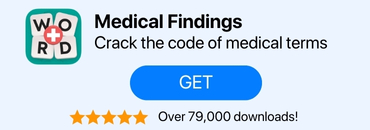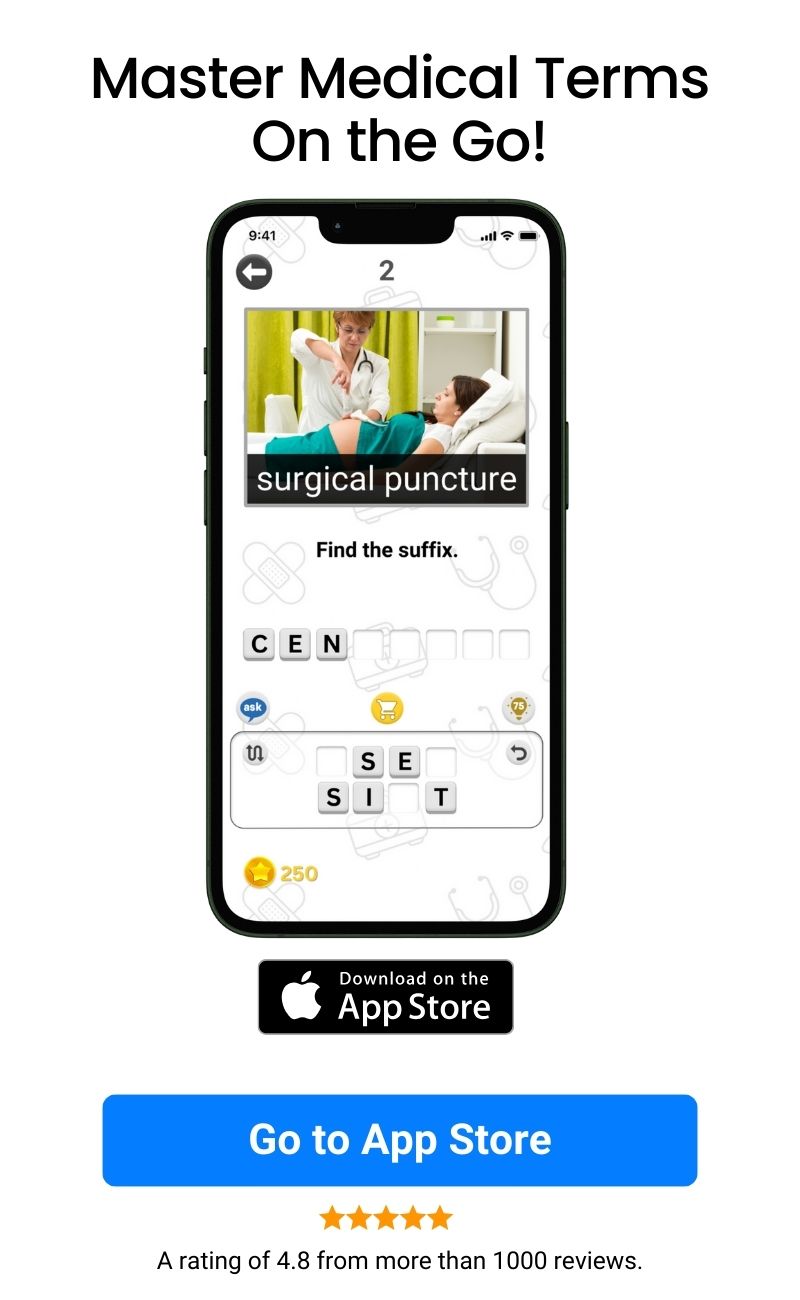Lastly, here is the last part of the quiz that we are giving you on the most common root words and combining forms that are used when we refer to the skeletal system.
Quick Review for the Quiz
Check out the flashcard version for a more detailed review.
| Word Root | Combining Form | Body Part or Condition |
|---|---|---|
| radi | radi/o |
radius (lateral forearm bone)
|
| sacr | sacr/o | sacrum |
| scapul | scapul/o | scapula (shoulder blade) |
| scoli | scoli/o | curved |
| spondyl, vertebr | spondyl/o, vertebr/o | vertebra |
| stern | stern/o | sternum (breastbone) |
| synov | synov/i |
synovial fluid, joint, or membrane
|
| tars | tars/o | tarsals (ankle bones) |
| ten, tendin, tend | ten/o, tendin/o, tend/o | tendon |
| tibi | tibi/o |
tibia (inner lower leg bone)
|
| uln | uln/o |
ulna (medial forearm bone)
|
-
Question of
Find the combining form of the image highlighted.

-
radi/o
-
forearm/o
-
burs/o
-
chondr/o
Correct Wrong
radi/o is a combining form that refers to "radius (lateral forearm bone)". In the forearm, the radius is one of two bones, the other being the ulna. Its primary function is to connect to the ulna and humerus at the elbow to facilitate supination (rotation of the forearm that results in the palm of the hand facing up) and pronation (rotation of the forearm that results in the palm of the hand facing down). Next, to coordinate all wrist movements with the scaphoid and lunate.
-
-
Question of
Find the combining form of the image highlighted.

-
sacr/o
-
carp/o
-
lord/o
-
aponeur/o
Correct Wrong
sacr/o is a combining form that refers to "sacrum". The sacrum is a shield-like skeletal structure that is positioned at the bottom of the lumbar vertebrae and connects the pelvis to the lower back. The sacrum is a part of the posterior pelvic wall and provides stabilization to the pelvis.
-
-
Question of
Find the combining form of the image highlighted.

-
scapul/o
-
should/o
-
cost/o
-
clavicul/o
Correct Wrong
scapul/o is a combining form that refers to "scapula (shoulder blade)". Located between and connecting the clavicle and the humerus, the scapula is also known as the shoulder blade. The scapula is a triangular, flat, sturdy bone that makes up the back part of the shoulder girdle. In addition to this, the scapula is also connected to a number of muscles. The scapula is an instrumental bone in the proper functioning of the shoulder joint. It is capable of engaging in six types of motion, allowing for full-fledged movement of the upper extremities
-
-
Question of
Find the combining form of the image highlighted.

-
scoli/o
-
curv/o
-
arthr/o
-
pelv/o
Correct Wrong
scoli/o is a combining form that refers to "curved". The condition of scoliosis involves a lateral curvature of the spine that is commonly seen during adolescence. It is known that scoliosis can develop in people with disabilities including cerebral palsy and muscular dystrophy, but the cause of most childhood scoliosis remains unclear. The majority of scoliosis cases are mild, but some curves become more severe with age.
-
-
Question of
Find the combining form of the image highlighted.

-
spondyl/o
-
scapul/o
-
menisc/o
-
coccyg/o
Correct Wrong
spondyl/o or vertebr/o is a combining form that refers to "vertebra". Vertebrae are the 33 cartilaginous or bony sections, interconnected bones that comprise the spinal column. Each of the vertebra has three primary functional parts: the vertebral body for weight bearing, the vertebral arch to provide protection for the spinal cord, and transverse processes for connecting the vertebral body to the ligaments.
-
-
Question of
Find the combining form of the image highlighted.

-
stern/o
-
breastb/o
-
fibul/o
-
ili/o
Correct Wrong
stern/o is a combining form that refers to "sternum (breastbone)". The sternum or breastbone is a flat, long bone that is positioned in the center of the chest. It is attached to the ribs by cartilage and makes up the front of the rib cage. By doing so, the heart, lungs, and major blood vessels are protected from injury. Similar in shape to a necktie, the sternum is one of the largest and longest in the flat bone in the body.
-
-
Question of
Find the combining form of the image highlighted.

-
synov/i
-
fluid/o
-
humer/o
-
cost/o
Correct Wrong
synov/i is a combining form that refers to "synovial fluid, joint, or membrane". Synovial fluid, also referred to as joint fluid, is a dense liquid found between your joints. When the joints move, the synovial fluid cushions the ends of the bones which minimizes friction between the joints.
-
-
Question of
Find the combining form of the image highlighted.

-
tars/o
-
ankl/o
-
chondr/o
-
disk/o
Correct Wrong
tars/o is a combining form that refers to "tarsals (ankle bones)". The tarsal bones are composed of seven short bones found in the proximal (closer to the center of the body) region of the foot. These bones give structural support to the foot's soft tissues, allowing the feet to bear the body’s weight. Combining with other foot bones the tarsal bones make up a longitudinal arch to provide a stable base of support during standing or walking.
-
-
Question of
Find the combining form of the image highlighted.

-
ten/o
-
scoli/o
-
phalang/o
-
disk/o
Correct Wrong
ten/o, tendin/o or tend/o is a combining form that refers to "tendon". Tendons are fibrous connective tissues that bind muscles to bone as well as connecting muscles to specific structures such as the eyeballs. Tendons help to facilitate the movement of the bone or structure they are attached to.
-
-
Question of
Find the combining form of the image highlighted.

-
tibi/o
-
oste/o
-
stern/o
-
mandibul/o
Correct Wrong
tibi/o is a combining form that refers to "tibia (inner lower leg bone)". The tibia, also called the shin bone, is the larger of the two bones in the lower leg. Fibula (calf bone) is another bone in the lower leg. A tibia is located closer to the center of your body (medial) than a fibula, extending from beneath the knee to the ankle. The tibia is the second biggest bone in the body and one of the main bones that bear the weight of the body when it stands and moves.
-
-
Question of
Find the combining form of the image highlighted.

-
uln/o
-
vertebr/o
-
myel/o
-
menisc/o
Correct Wrong
uln/o is a combining form that refers to "ulna (medial forearm bone)". The ulna is one of the bones that form the forearm, along with the radius. It is located in the middle and lies next to the radius. The ulna serves as the supporting bone, with the radius turning to create movement. Pronation and supination of the forearm and hand are aided by the ulna.
-




